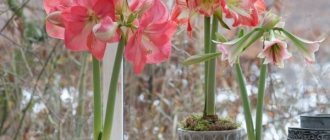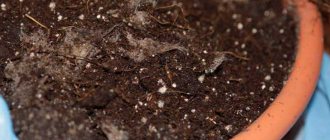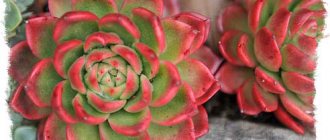Botanical description of the Sprekelia flower
Sprekelia is a representative of the American continent, its homeland is Mexico and Guatemala. The plant was introduced to Europe in 1568 and was first described and named by Swedish botanist Carl Linnaeus as Amaryllis formosissima. Later, in 1821, the British botanist William Herbert renamed the flower in honor of J. H. von Spreckelson, a German lawyer and gardener. In everyday life, this flower has a more refined, romantic name. It is often called the Templar Lily or the Aztec Lily.
Sprekelia Karwinskii
Sprekelia is a member of the Amaryllidaceae family. Sprekelia is a bulbous plant 30 centimeters high. An adult bulb can reach ten centimeters in diameter. The leaves of the flower are rich green in color with a shiny surface, have a narrow, lanceolate shape and can grow up to 60 cm.
Although early summer is the time for these beautiful red flowers to bloom, they can sometimes bloom at other times of the year if Sprequelia is grown in a greenhouse or as a houseplant. With good care it can bloom again in early autumn. During flowering, a smooth, reddish-brown peduncle appears, growing to about thirty centimeters. The peduncle is crowned with a very large, asymmetrical flower.
Six long petals curl ornately, forming an interesting flower shape. Petals can be different shades of red. Many long, delicate stamens are crowned with yellow, bright pollen. Sprekelia exudes a delicate, pleasant aroma during flowering.
An Aztec lily grown from seed can begin to bloom in 7 years.
Popular varieties
The most famous varieties of the crop:
- Karwinskii - distinguished by petals of a crimson hue and a white edge.
- Orient Red – red petals, white blotches in the longitudinal direction;
- Peru – has dark red buds.
How to plant and care for Sprekelia flowers in the garden
It’s worth mentioning right away that Sprekelia is a heat-loving plant and does not tolerate frost. Therefore, if you decide to grow this flower in your garden, you need to be prepared to provide it with a warm place during the cold season. We will talk about this and other features below.
Temperature conditions
Sprekelia feels great in summer at temperatures from 20 to 22 degrees, and in the winter months - above 7 degrees Celsius.
You might be interested
Features of the perennial plant Arabis
Ageratum - blooming garden decoration
Anafalis - an original garden decoration
What soil is suitable for a Sprekelia flower?
The soil should be loose, with a low acidity content (pH 5.5–6.5) and have good moisture permeability. There should be a layer of drainage at the bottom of the pot or planting hole.
Air humidity
Sprekelia flower is a moisture-loving plant. If the ambient temperature is about 15 degrees, then the minimum humidity level should be 50 percent. This needs to be taken into account, especially during the winter months.
Lighting
The flower needs to be provided with bright light. The plant should be exposed to direct sunlight for at least 4 hours a day.
If you live in warmer regions, it is worth giving the flower a place with partial light and light shade.
How to plant Sprekelia correctly
This flower can be grown from seeds, but this is a rather long process and such a plant will not bloom immediately, but after several years. The best option would be to purchase Sprekelia bulbs. When growing outdoors, wait until the soil has warmed and the danger of frost has passed before planting the bulbs in well-drained soil, such as a rock garden.
Before planting, prepare the site by mixing organic fertilizer (compost or sphagnum) into the soil, then plant the bulbs about half their height, being careful not to disturb the roots. After planting, moisten the soil generously.
Watering
During the growing season and flowering period, the soil is moistened 1 or 2 times every 7 days. Moisture should not stagnate in the soil.
If you planted a flower in open ground, take into account the amount of natural precipitation. In winter, it is necessary to reduce the frequency of watering for domestic Sprekelia.
Fertilizer
Sprekelia will be grateful to you if during the growing season you feed it twice a month with liquid fertilizers containing phosphorus and potassium and less nitrogen. In winter, domestic Sprekelia is not fed.
Wintering of Sprekelia
Considering that the plant is not frost-resistant, the bulbs are removed from open ground in late autumn. The bulbs, cleared of soil and dried leaves, are placed in dry peat. Without watering, in a dry room, at a temperature of about 10 degrees, the tubers overwinter well. In the spring, after the frosts have ended and the soil has warmed up, the bulbs can be planted.
If you live in regions with warm, snowless winters, you don’t have to dig up the bulbs, but cover them with a thick layer of mulch. This will ensure their safety from possible frosts.
Transplanting Sprekelia
Early fall is the ideal time to replant Aztec lilies. If you plan to move or divide this plant, allow the soil to dry completely. Dig up flower bulbs when they are dormant (after flowering has finished). Select a replanting site with fast-draining soil that receives adequate sunlight. Pre-prep the site or prepare the potting soil by mixing compost with rich potting soil and perlite, then plant the bulbs as described above.
Diseases and pests
Problems when growing sprekelia arise quite rarely and in most cases their occurrence is associated with improper care of the crop. The list of common lesions includes:
- yellowing of leaves - the air humidity in the room is insufficient;
- lack of flowering - lack of sun or nutrients in the soil;
- pale leaves - lack of watering;
- darkening or rotting of buds - the room has high humidity, the soil is overwatered;
- If the growth of the crop has slowed down, the bulb should be checked for pest damage.
Remember that if sprekelia grew in open ground, there is a high probability of it becoming infected with various pests. The bulb should be carefully examined for thrips, aphids, scale insects and spider mites. If there are no problems, it is recommended to carry out preventive treatment with a systemic insecticide, once enough.
Young bulbs produce a short peduncle.
Sprekelia, as a crop for indoor floriculture, is poorly distributed. But gardeners who are interested in growing amaryllis should get to know this plant. The Aztec lily captivates with its beauty and grace - lightning fast, and its aroma captivates. There are some difficulties in growing, but they pay off in full when you get a flowering specimen.
How to propagate Sprekelia flower
There are two ways - with daughter bulbs and seeds.
When propagating from bulbs, you should wait for the foliage to dry out before you dig the plant's tubers out of the soil. Then divide the group of tubers into individual bulbs with your hands. Leave the bulbs in a cool place until spring. In spring, plant them about 7 cm deep in prepared soil. Leave about 20 inches of space between the bulbs and make sure their necks stick out slightly from the ground after planting. Often young seedlings begin to bloom within two months after propagation.
The seed method is quite labor-intensive and not as effective. To collect a seed from a Sprekelia, you will need to pollinate its flowers. Seedlings obtained from seeds will not retain the varietal characteristics of the parent bush. The collected seeds must be sown within five weeks, otherwise they will not germinate. Therefore, we will not consider the seed method.
Reproduction
Every year, daughter bulbs are formed on the mother plant. They serve as material for vegetative propagation of Sprekelia. When transplanting, they must be separated and planted in separate small pots. The bulbs are dark, almost black. Elite bulbs reach 3 cm in diameter. They are planted half immersed in the soil mixture.
Plants can also be propagated by grown seeds. After flowering, the seeds are collected and sown in mini greenhouses. Every day such a greenhouse must be ventilated to avoid rotting of the seedlings. After 2 - 3 weeks, shoots appear. They are picked, seated in separate containers.
Popular varieties of Sprekelia
You are unlikely to find a wide variety of this exotic plant in garden centers. But still we will introduce you to well-known species and varieties.
Sprekelia most beautiful or magnificent (Sprekelia formosissima)
The most famous and popular type of flower. In the west it is better known as the Jacobin Lily or the Aztec Lily. This species is a delicate bulbous perennial plant with bright red flowers up to 15 cm in diameter, located singly on fairly short, strong stems. Each flower resembles an orchid and consists of 6 petals: 3 widely spread upper petals, curved back at the ends, and 3 drooping lower petals, part of their length curled into a cylinder. The flowering season is from late spring to early summer, and sometimes in autumn. The long, dark green leaves appear in the spring at about the same time as the flowers. Each bulb produces several leaves. The height of Sprekelia magnificent is up to 30 cm in height.
The most famous varieties of Sprekelia:
- Karwinskii - distinguished by petals of a crimson hue and a white edge.
- Orient Red – red petals, white blotches in the longitudinal direction;
- The Sprekelia flower of the Peru variety has dark red buds.
This article uses materials from plantcaretoday.com











